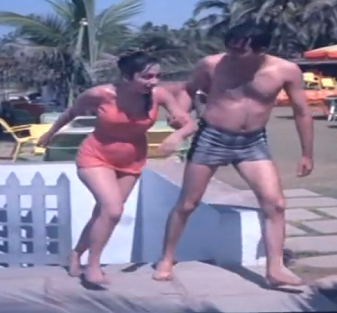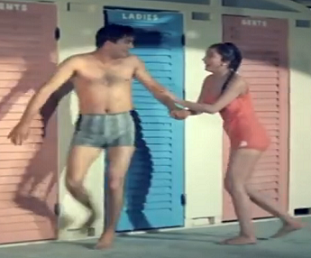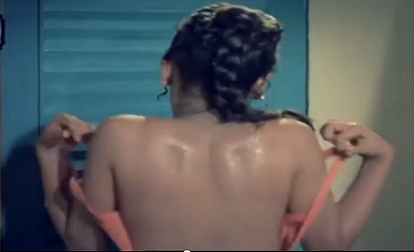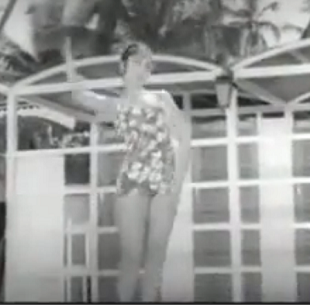Sadhana, actress
(→Filmography) |
|||
| (3 intermediate revisions by one user not shown) | |||
| Line 1: | Line 1: | ||
[[File: Waqt1.png|Sadhana: with Sunil Dutt in '' Waqt'' (1965).This was one of her few swimsuit appearances; she also appeared in one in Budtameez. (See [[Shammi Kapoor]] |frame|500px]] | [[File: Waqt1.png|Sadhana: with Sunil Dutt in '' Waqt'' (1965).This was one of her few swimsuit appearances; she also appeared in one in Budtameez. (See [[Shammi Kapoor]] |frame|500px]] | ||
| − | [[File: Rajkumar.png|(Sadhana) and her BFFs under a waterfall in Rajkumar (1964). Sadhana played a tribal princess in the film. <br/>Till the | + | [[File: Rajkumar.png|(Sadhana) and her BFFs under a waterfall in Rajkumar (1964). Sadhana played a tribal princess in the film. <br/>Till the 1990s, when the tribal genre was finally abandoned by Hindi-Urdu cinema, in all films with some tribal characters there would be an almost mandatory sequence showing tribal women bathing in a stream or under a waterfall. This was done partly because Filmistan wanted to reassure urban audiences that the tribals (only the women and never the men) bathed regularly, and partly to take the message of regular ablutions to the tribals.|frame|left|500px]] |
[[File: Waqt3.png|'' Waqt'' (1965): (Sadhana) tells (Sunil Dutt) that he is entering the wrong, i.e. the women’s, shower cabin. She stops him from entering the ''blue'' door! |frame|500px]] | [[File: Waqt3.png|'' Waqt'' (1965): (Sadhana) tells (Sunil Dutt) that he is entering the wrong, i.e. the women’s, shower cabin. She stops him from entering the ''blue'' door! |frame|500px]] | ||
| − | [[File: Waqt2.png|'' Waqt'' (1965): (Sadhana) slips in the water around the shower; (Sunil Dutt) steadies her. <br/> And film journalists had the nerve to make fun of [[Sridevi]]'s 'thunder thighs.' |frame|left|500px]] | + | [[File: Waqt2.png|'' Waqt'' (1965): (Sadhana) slips in the water around the outdoor shower; (Sunil Dutt) steadies her. <br/> And film journalists had the nerve to make fun of [[Sridevi]]'s 'thunder thighs.' |frame|left|500px]] |
[[File: Waqt4.png|'' Waqt'' (1965): Despite director Yash Chopra’s pretences to Western sophistication, this meant that the female (Sadhana) went to the blue shower room, while the man (Sunil Dutt) was directed to the pink shower room. |frame|left|500px]] | [[File: Waqt4.png|'' Waqt'' (1965): Despite director Yash Chopra’s pretences to Western sophistication, this meant that the female (Sadhana) went to the blue shower room, while the man (Sunil Dutt) was directed to the pink shower room. |frame|left|500px]] | ||
[[File: Waqt5.png|'' Waqt'' (1965): (Sadhana) begins to take her swimsuit off in the blue shower room. |frame|500px]] | [[File: Waqt5.png|'' Waqt'' (1965): (Sadhana) begins to take her swimsuit off in the blue shower room. |frame|500px]] | ||
| Line 21: | Line 21: | ||
Born: September 2, 1941 in Karach | Born: September 2, 1941 in Karach | ||
| + | =Biographical details = | ||
| + | [http://epaperbeta.timesofindia.com/Article.aspx?eid=31808&articlexml=Sadhana-whose-hairdo-defined-an-era-dead-26122015008067 Avijit Ghosh Dec 26 2015 PTI] | ||
| + | |||
| + | Actor Sadhana will be remembered for many songs, sequences and films. But, her fringe haircut -that millions of teenage girls imitated, and who are all senior citizens today -was a rage which astonishingly found its way to Bihar's political phenomenon Lalu Prasad's forehead in his younger days. | ||
| + | |||
| + | Then, there is the defini tive wolf-whistle track from the film, Mera Saaya, `Jhumka gira re', where her shimmy caused pandemonium in mofussil theatres and immortalised a woman's earrings into a totem of desire.But, most importantly , it was Sadhna's impressive catalogue of box-office super hits -`Mere Mehboob', `Woh Kaun Thi', `Arzoo', `Waqt' -that made her a favorite of top filmmakers in the mid-1960s. A Karachi-born Sindhi, whose family fled to Mumbai in the violent days of Partition -Shivdasani is her maiden surname -Sadhana was named after the 1940s Bengali actor Sadhana Bose. | ||
| + | |||
| + | She acted in the first Sindhi film, ` Abana', but was re-introduced along with Joy Mukerji as new sensations in `Love in Simla' (1960) made by premier production house Filmalaya. In the role of a tomboy who discovers the raptures of love after resisting its pull, she was immediately marked for stardom. The film was directed by R K Nayyar, whom she married later. | ||
| + | |||
| + | In her black and white days of early 1960s, Sadhana largely played a range of roles sans glamour which became her calling card as the decade advanced. Bimal Roy's `Prem Patra' and `Parakh' (where she lipsynced two superlative Salil Chowdhury melodies, `O.. sajana .. barkha bahar aayee' and `Mila hai kisi ka humka'), `Hum Dono', `Manmauji', `Ek Musafir Ek Haseena' and ` Asli Naqli' broadly belong to this category. | ||
| + | |||
| + | With the arrival of colour, as heroines became flippant and urbanised as per the demands of plot or the lack of it, Sadhana slipped effortlessly into the new order. But before that she got to play Husna, the sort of girl every man with poetry in his heart would fall or. No film framed her beauty better than HS Rawail's `Mere Mehboob' (1963), a coy romantic Muslim social that became the year's biggest box-office success. | ||
| + | |||
| + | In `Waqt' and `Arzoo', two blockbusters of 1965, Sadhana was at her prime where she typified the commercial heroine of the era: stylish and always ready to be serenaded by a song. It was around this period that her face became synonymous with beauty accessories and the calendar in men's sa loons. She had become a style icon. Even though her sleeveless kurtas and suffocating, hip-hugging churidaars could choke a stray insect, tailors were ordered to make it tighter by eager fans. | ||
| + | |||
| + | A thyroid problem took away her svelte and sizzle.But Sadhana continued to appear in films. The hits had dried up by the early 1970s though Devendra Goel's `Ek Phool Do Mali' (1969) was an exception. Even Rajesh Khanna in his prime delivered flop with her in `Dil, Daulat aur Duniya' (1972). Her last hit was the thriller `Geeta Mera Naam', where she was both the leading lady and the director, a first of sorts. | ||
| + | |||
| + | By the late 1970s, Sadhana had faded away . But her strong inventory ensures that she will continue to be seen on classic cinema channels on TV . And the haircut that goes by her name will endure long after the RJD supremo retires from politics. | ||
| + | |||
| + | Actor Sadhana, 74, passed away following a brief illness in Mumbai in Dec 2015. | ||
=Filmography= | =Filmography= | ||
==As an actress== | ==As an actress== | ||
Latest revision as of 20:20, 26 December 2015


Till the 1990s, when the tribal genre was finally abandoned by Hindi-Urdu cinema, in all films with some tribal characters there would be an almost mandatory sequence showing tribal women bathing in a stream or under a waterfall. This was done partly because Filmistan wanted to reassure urban audiences that the tribals (only the women and never the men) bathed regularly, and partly to take the message of regular ablutions to the tribals.

And film journalists had the nerve to make fun of Sridevi's 'thunder thighs.'

This was considered the most erotic sequence ever shown in an Indian film till then because of the implied stripping off of the swimsuit’s top.
It was also applauded for the way it built up tension in the mind of the third angle of the film’s love triangle. (Raaj Kumar) was in the corridor outside the two adjacent shower rooms, eavesdropping on the lovebirds’ conversation, seething with jealousy, and unconsciously lighting matchstick after matchstick.
This is a collection of articles archived for the excellence of their content.
|
Contents[hide] |
[edit] Personal details
Full name: Sadhana Shivdasani
Born: September 2, 1941 in Karach
[edit] Biographical details
Actor Sadhana will be remembered for many songs, sequences and films. But, her fringe haircut -that millions of teenage girls imitated, and who are all senior citizens today -was a rage which astonishingly found its way to Bihar's political phenomenon Lalu Prasad's forehead in his younger days.
Then, there is the defini tive wolf-whistle track from the film, Mera Saaya, `Jhumka gira re', where her shimmy caused pandemonium in mofussil theatres and immortalised a woman's earrings into a totem of desire.But, most importantly , it was Sadhna's impressive catalogue of box-office super hits -`Mere Mehboob', `Woh Kaun Thi', `Arzoo', `Waqt' -that made her a favorite of top filmmakers in the mid-1960s. A Karachi-born Sindhi, whose family fled to Mumbai in the violent days of Partition -Shivdasani is her maiden surname -Sadhana was named after the 1940s Bengali actor Sadhana Bose.
She acted in the first Sindhi film, ` Abana', but was re-introduced along with Joy Mukerji as new sensations in `Love in Simla' (1960) made by premier production house Filmalaya. In the role of a tomboy who discovers the raptures of love after resisting its pull, she was immediately marked for stardom. The film was directed by R K Nayyar, whom she married later.
In her black and white days of early 1960s, Sadhana largely played a range of roles sans glamour which became her calling card as the decade advanced. Bimal Roy's `Prem Patra' and `Parakh' (where she lipsynced two superlative Salil Chowdhury melodies, `O.. sajana .. barkha bahar aayee' and `Mila hai kisi ka humka'), `Hum Dono', `Manmauji', `Ek Musafir Ek Haseena' and ` Asli Naqli' broadly belong to this category.
With the arrival of colour, as heroines became flippant and urbanised as per the demands of plot or the lack of it, Sadhana slipped effortlessly into the new order. But before that she got to play Husna, the sort of girl every man with poetry in his heart would fall or. No film framed her beauty better than HS Rawail's `Mere Mehboob' (1963), a coy romantic Muslim social that became the year's biggest box-office success.
In `Waqt' and `Arzoo', two blockbusters of 1965, Sadhana was at her prime where she typified the commercial heroine of the era: stylish and always ready to be serenaded by a song. It was around this period that her face became synonymous with beauty accessories and the calendar in men's sa loons. She had become a style icon. Even though her sleeveless kurtas and suffocating, hip-hugging churidaars could choke a stray insect, tailors were ordered to make it tighter by eager fans.
A thyroid problem took away her svelte and sizzle.But Sadhana continued to appear in films. The hits had dried up by the early 1970s though Devendra Goel's `Ek Phool Do Mali' (1969) was an exception. Even Rajesh Khanna in his prime delivered flop with her in `Dil, Daulat aur Duniya' (1972). Her last hit was the thriller `Geeta Mera Naam', where she was both the leading lady and the director, a first of sorts.
By the late 1970s, Sadhana had faded away . But her strong inventory ensures that she will continue to be seen on classic cinema channels on TV . And the haircut that goes by her name will endure long after the RJD supremo retires from politics.
Actor Sadhana, 74, passed away following a brief illness in Mumbai in Dec 2015.
[edit] Filmography
[edit] As an actress
1958 Abana (Sindhi)
1959 Bus Conductor
1960 Love in Simla
1960 Parakh
1962 Asli-Naqli
1962 Ek Musafir Ek Hasina
1962 Hum Dono
1962 Man-Mauji
1962 Prem Patra
1963 Mere Mehboob
1964 Dulha Dulhan
1964 Picnic
1964 Rajkumar
1964 Woh Kaun Thi?
1965 Arzoo
1965 Waqt
1966 Budtameez
1966 Gaban
1966 Mera Saaya
1967 Anita
1968 Stree
1969 Ek Phool Do Mali
1969 Intaquam
1969 Sachaai
1970 Ishq Par Zor Nahin
1971 Aap Aye Bahaar Ayee
1972 Dil Daulat Duniya
1973 Hum Sab Chor Hain
1974 Chhote Sarkar
1974 Geetaa Mera Naam
1975 Vandana
1977 Amaanat
1981 Mahfil
1994 Ulfat Ki Nayee Manzilen
[edit] As a director
1974 Geetaa Mera Naam




